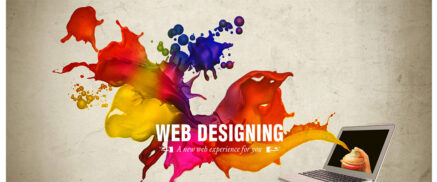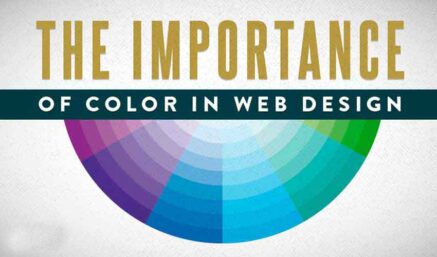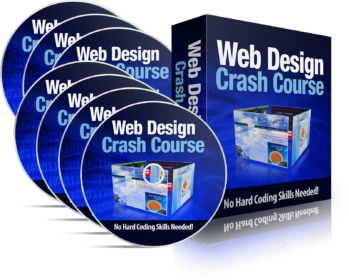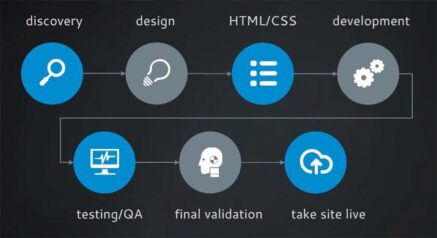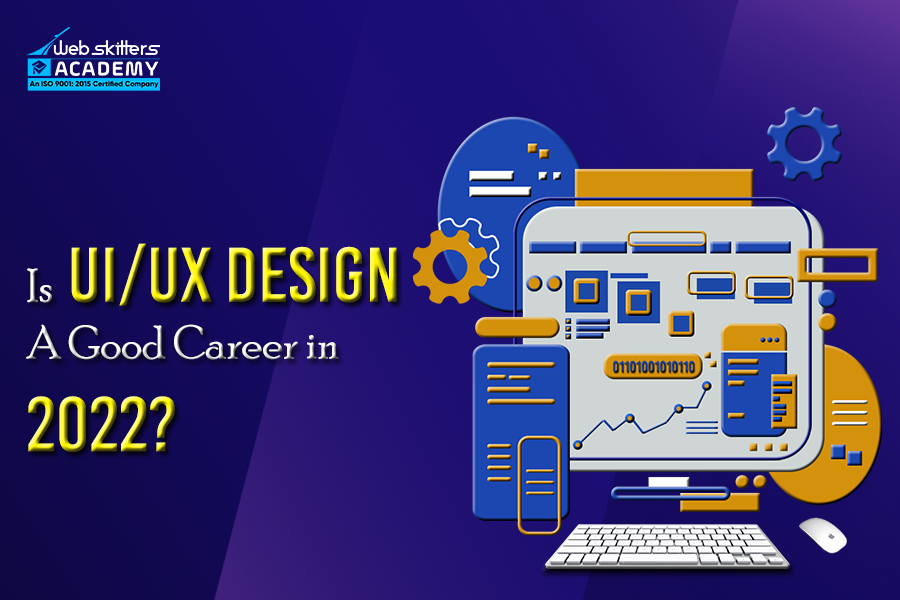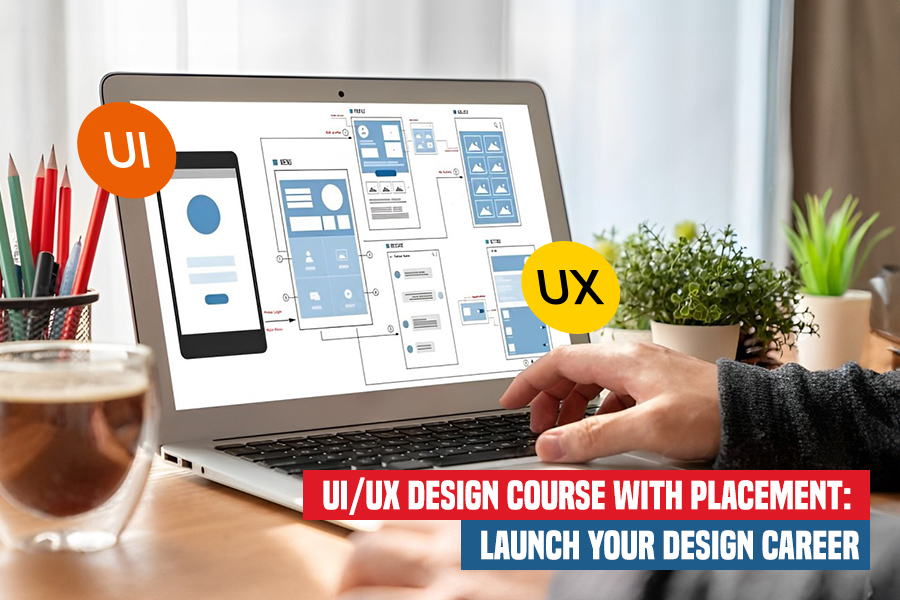
Are you curious about how to become a brilliant UI/UX designer in India? The pay scale is impressive, and lucrative opportunities are available in the market.
India is progressively becoming a technological hub for aspiring candidates to explore numerous job roles. You only need efficient skills to penetrate the job market and become a web designer or developer.
However, today, let us explore how to become a professional UI/UX designer. Strong foundational knowledge about UI and UX is essential to cracking a reputable position. If you lack a technical background, a prominent UI/UX design course with placement guidance is the ideal support.
Before all, let’s learn what UI/UX is and how to become a professional with an advanced UI/UX design course. We will also explore the course’s intricacies and the core components of the learning program.
What is UI/UX Design?
UI/UX design is a rapidly growing domain focusing on curating digital products that are visually appealing and user-friendly. If you are a beginner venturing into digital creations, let us break down what these terms mean –
UI (User Interface) design concerns the visual elements of a digital presence. It focuses on buttons, colours, typography, and layout. It is about making the product look and feel attractive and intuitive for users.
UX (User Experience) design is about the user experience when interacting with a web presence or digital product. It involves understanding user needs, behaviours, and goals, designing products that meet those needs, and making the user’s journey as smooth and enjoyable as possible.
While UI and UX design are discussed together, they are distinct yet complementary fields. UX design focuses on the bigger picture of the presence, ensuring the product is usable, accessible, and meets the user’s expectations. UI design brings the vision to life by creating a visually appealing and intuitive interface.
In this tech-driven era, the importance of UI/UX design in the digital sphere cannot be overstated. With increasing competition among users, businesses strive to create products that stand out in functionality and user experience. A well-designed UI and UX increases user satisfaction, engagement, and loyalty. Therefore, the need for skilled UI/UX designers is rising, making it a lucrative career opportunity.
Why Choose a UI/UX Design Course with Placement?
Choosing a UI/UX design course with placement must be strategic. It will set you up for success in the tech industry and offer promising foundational skills. Here are some of the critical advantages of joining the best UI/UX design course in Kolkata –
1. Guaranteed Job Opportunities
The most significant benefit of enrolling on a UI/UX design course with placement is the job assurance and market guidance. The programs have strong industry partnerships, guaranteeing placements for their students. It can significantly reduce the stress and uncertainty associated with job hunting, especially for those new to the field.
2. Industry Connections
In addition to guaranteed placements, UI/UX design courses provide students with valuable industry connections. These connections can be invaluable for networking, learning about new trends and technologies, and securing future job opportunities.
3. Career Launchpad
In a UI/UX design course for beginners, placement can be a crucial stepping stone towards a successful market experience. The programs provide hands-on training, mentorship, and guidance, equipping students with the skills and knowledge essential to excel in the field.
The placement opportunity offers the chance to gain practical experience and build a professional portfolio.
UI/UX Design Courses in Kolkata and Other Cities
Kolkata, a central IT hub in India, offers a variety of UI/UX design courses with placement. Many reputable institutions and training centres in the city provide comprehensive programs catering to the needs of aspiring UI/UX designers.
Therefore, choosing a UI/UX design course with placement in Kolkata significantly enhances your career prospects and sets you up for success in the dynamic and growing field of website design and development.
What Will You Learn in a UI/UX Design Course?
Whether you opt for a UI/UX design course for beginners or otherwise, learning the fundamentals for a sturdy knowledge base is mandatory. This section explores the typical content of a UI/UX design course to help you choose wisely.
It is vital to understand that a UI/UX design course equips students with comprehensive skills. These are essential for success in the field and stay ahead of the competitors.
Let us break down the core components of a typical UI/UX design program –
1. UI/UX Design Fundamentals
- Understanding User Behaviour: Gain insights into how users think, feel, and perceive messages when interacting with digital products. Learn to empathise with users and identify their needs and pain points.
- User Research Methods: Master various research techniques, such as interviews, surveys, and usability testing, to gather valuable user data. Data is optimum for delivering the best UI/UX design, especially when working for an organisation.
- Design Principles: Understand fundamental design principles like consistency, hierarchy, and accessibility to create visually appealing and intuitive interfaces. These are foundation features of a design and contribute to the end product.
2. Wireframing and Prototyping
- Wireframing: Create low-fidelity representations of user interfaces to visualise the product structure and layout. Wireframes help understand the flow of information and identify potential usability issues.
- Prototyping Tools: Learn to use tools like Figma, Adobe XD, or Sketch to create interactive prototypes that simulate the final product’s functionality. Prototypes allow early testing and feedback, ensuring the design meets user expectations.
Mastering a range of UI/UX design tools is crucial to getting hired by reputable organisations in Kolkata and other IT hubs. A proficient course ensures that all tools are covered by skilled industry mentors.
3. Advanced UI/UX Design Techniques
- Information Architecture: Organise content and structure information, making it easy for users to understand and navigate. A complicated UI leads to user abandonment and an increased bounce rate.
- Interaction Design: Design interactions must be intuitive, efficient, and enjoyable. Consider factors like affordances, feedback, and mental models.
- Accessibility: Ensure the digital products are usable by people with disabilities. Learn about accessibility guidelines and best practices to create inclusive designs.
4. Design Tools and Workflow
- Mastering Design Tools: Gain proficiency in industry-standard tools like Figma, Adobe XD, or Sketch. Learn to use these tools effectively to create high-quality designs.
- Design Thinking: Understand and apply the design thinking process to solve complex design problems. Embrace a human-centred approach to design to deliver maximum usability.
- Collaboration and Communication: Develop strong communication and collaboration skills to work effectively with teams of designers, developers, and stakeholders.
5. Portfolio Development
- Creating a Strong Portfolio: Learn how to curate a portfolio and effectively showcase UI/UX design skills. A well-crafted portfolio is essential for landing interviews and demonstrating your capabilities to potential employers.
- Highlighting Real-World Projects: Include case studies of real-world projects in your portfolio to demonstrate your ability to solve complex design problems. Explain the design process, challenges faced, and solutions implemented. Enrolling in a reputable UI/UX design course in Kolkata helps; they provide real-time projects for users to gain foundational skills.
A UI/UX design program provides you with theoretical knowledge and equips learners with practical skills through hands-on projects.
Understand user behaviour, conduct market research, create wireframes and prototypes, and effectively utilise design tools. These steps prepare candidates to tackle real-world design challenges and launch a successful UI/UX design career.
Career Opportunities after a UI/UX Design Course
A UI/UX design course opens doors to exciting career opportunities across various industries. The demand for UI/UX designers in the job market is increasing by the day. Therefore, all the candidate must do is master the intricacies of UI/UX to land a desirable job role.
Here are some of the most common job roles and the growing demand for UI/UX designers –
Job Opportunities for UI/UX Designers
- UI/UX Designer: The most common role for UI/UX professionals. They are responsible for creating visually appealing and user-friendly interfaces for websites, apps, and other digital products.
- Product Designer: Product designers work closely with development teams to create entire products, from idea session to launch. They are responsible for the user experience and the overall design.
- Interaction Designer: Interaction designers focus on the interaction between users and digital products. They design the interface flow and behaviour, ensuring intuitiveness and usability.
- User Experience Researcher: UX researchers analyse markets to understand user needs and behaviours. They use various methods, including interviews and usability testing, to gather data and inform design decisions.
- Information Architect: Information architects organise content and structure information for users to comprehend and navigate seamlessly. They create sitemaps, wireframes, and other documentation to guide the design process.
Growing Demand for UI/UX Designers
The demand for UI/UX designers is steadily increasing, driven by the growing importance of user experience in the digital age. Recognising that a well-designed product significantly improves user satisfaction, engagement, and loyalty is vital.
Hence, the high demand for skilled UI/UX designers across various industries is justified. Learners can explore multiple domains, including technology, e-commerce, healthcare, finance, and more.
UI/UX Designer Salary
The salary for UI/UX designers varies depending on experience, location, industry, and company size. However, in general, UI/UX designers can expect competitive salaries.
Certified with UI/UX design courses with placement often have a good starting point. The placement itself provides valuable experience and connections.
With the increasing demand for skilled UI/UX professionals, candidates for these courses are well-positioned to secure rewarding careers in various industries.
How to Choose the Best Institute for UI/UX Design Course?
Choosing the ideal UI/UX design course significantly impacts the career trajectory. While a structured course ensures that essential concepts are trained, an average course might lack training procedures.
Here are some key factors to consider when selecting a UI/UX design program –
1. Course Content
- Comprehensive Coverage: Ensure the course covers UI and UX design, from fundamental concepts to advanced techniques. A well-rounded curriculum provides a solid foundation and prepares you for the challenges of real-world design projects.
- Hands-On Projects: Look for courses that emphasise practical learning through hands-on projects. These projects help you apply the knowledge, develop problem-solving skills, and create a portfolio that showcases your work.
2. Placement Support
- Job Placement Services: Consider courses that offer job placement services, like career counselling, resume building, and interview preparation. They increase your chances of landing a job after graduation.
- Industry Partnerships: Esteemed institutes have strong partnerships with design companies, which often provide better placement opportunities. These partnerships also offer internships and networking opportunities.
3. Certifications
- Industry-Recognised Certifications: Opt for courses that offer industry-recognised certifications. Certifications validate your skills and make you more worthy of potential employers.
- Value of Certifications: While certifications are valuable, they must not be the sole factor in your decision. Focus on courses that provide a comprehensive education, practical skills, and certifications.
4. Practical Projects
- Real-World Experience: Select courses that involve working on real-world projects, either individually or in teams. These practical projects in UI/UX design courses provide valuable experience and allow learners to apply their knowledge to solve real-world challenges.
- Portfolio Building: Practical projects contribute to UI/UX portfolio development, which is essential for showcasing skills to potential employers.
5. Industry Connections
- Networking Opportunities: Consider institutes with solid industry connections or partnerships with design companies and internship opportunities. These connections provide valuable networking opportunities and help stay updated on industry trends.
- Mentorship: Some courses offer mentorship programs that connect students with experienced professionals in the field. Mentorship provides professional guidance, support, and valuable insights.
Carefully consider these factors and choose a UI/UX design training institute that best aligns with your career goals and sets you up for success.
Remember, the most crucial thing is to select a course that provides the skills, knowledge, and practical experience to become a UI/UX designer and excel at it.
Benefits of Taking the Best UI/UX Design Course in Kolkata
Kolkata is emerging as a significant hub for the tech and creative industries. The room for skilled designers and developers is expanding, creating mass opportunities. The growth has created a surge in demand in reputable organisations across sectors.
Here is where pursuing a UI/UX design course in Kolkata offers several distinct advantages –
- Thriving Tech and Creative Scene
Kolkata’s tech industry is experiencing rapid growth, with numerous startups and established companies setting up operations in the city. The growth has created a demand for talented UI/UX designers to develop innovative, user-friendly digital products.
Kolkata’s vibrant creative scene also stimulates designers’ collaboration with artists, marketers, and other creative professionals. The city offers distinct opportunities to explore beautiful opportunities beyond the basics of website design.
Top UI/UX Design Training Institutes
Kolkata has several reputable UI/UX design training institutes offering high-quality programs and vital placement records. The institutes provide comprehensive training, industry-relevant curriculum, and hands-on experience to equip students with the skills needed to succeed.
- Affordability
Compared to other major cities in India, Kolkata offers affordable living. Students can pursue a UI/UX design course without breaking the bank. The lower cost of living helps students save money and focus on their studies. Additionally, if the courses are delivered online, the UI/UX design course can be accessed globally for career growth.
- Industry Opportunities
Kolkata’s growing tech and creative industries offer ample opportunities for UI/UX designers to find employment and build successful careers. The diverse range of industries, from IT and e-commerce to healthcare and finance, provides various options for designers to explore.
- Cultural Experience
Beyond the professional benefits, studying in Kolkata offers a unique cultural experience. The city’s rich history, diverse traditions, and vibrant arts scene make it a fascinating place to live and learn. Interacting with people from different backgrounds can broaden your perspective and enhance your creativity.
Pursuing a UI/UX design course in Kolkata offers a combination of academic excellence, industry opportunities, affordability, and a unique cultural experience. Opting to study in Kolkata, you can position yourself for a successful career in the dynamic UI/UX design field.
- Building a Strong UI/UX Design Portfolio
A well-crafted portfolio is vital for showcasing your UI/UX design skills and landing a job in the field. It visually represents your abilities, allowing potential employers to assess your design thinking, problem-solving skills, and aesthetic sense.
The UI/UX portfolio is your branding tool. It should effectively communicate your unique style, expertise, and passion for design.
A strong portfolio helps learners stand out from the competition, attract the attention of recruiters, and secure interviews with top companies.
What to Include in Your Portfolio?
- Real-World Projects: Showcase your best work by including real-world projects you have completed. These can be personal projects, freelance assignments, or projects from the UI/UX design course.
- Case Studies: For each project, include a detailed case study that outlines the design challenge, your approach, the solutions you implemented, and the outcomes. This will demonstrate your ability to think critically, solve problems, and deliver results.
- Design Process: Highlight the design process you followed for each project. It includes your research, ideation, prototyping, testing, and iteration phases. Each factor showcases your understanding of the design thinking process and your ability to work systematically.
- Visual Appeal: Ensure the portfolio is visually appealing and easy to navigate. Use high-quality images and consistent branding to create a professional and cohesive presentation.
- Quantifiable Results: Whenever possible, include quantifiable results to demonstrate the impact of your designs. It could include metrics like increased user engagement, improved conversion rates, or positive user feedback.
How does a UI/UX Design Course help build a Portfolio?
A UI/UX design course with certification provides the tools and guidance needed to build a strong portfolio. With hands-on projects, students can develop design skills and create a body of work to showcase in the portfolio. Additionally, your instructors can provide feedback and mentorship to help you refine your portfolio and make it stand out.
Implementing these tips and leveraging the resources provided by the course creates a compelling portfolio. It effectively showcases the skills and helps you land your dream job.
Remember, a strong portfolio showcases your designs by telling a story and demonstrating your value as a UI/UX designer.
Practical Projects and Real-World Experience
Amidst UI/UX design career growth, practical projects reinforce theoretical knowledge. They prepare students for real-world challenges and make them capable of navigating the job market.
Working on hands-on projects helps students apply their skills, develop problem-solving abilities, and gain valuable experience sought after by employers.
Typical UI/UX Projects Include –
- Mobile App Interfaces: Designing user-friendly interfaces for mobile apps, considering screen size, touch interactions, and user goals.
- Website Redesigns: Reimagining existing websites to improve usability, accessibility, and visual appeal while maintaining brand consistency.
- User Testing Case Studies: Conduct UX research and user testing in UI/UX design to gather insights into user behaviour, identify pain points, and validate design decisions.
- Branding and Identity Design: Creating visual identities and personas for brands, including logos, colour palettes, and typography.
- Information Architecture: Organising content and structuring information that is easy for users to understand and navigate.
Preparing for Real-World Challenges:
Through these practical projects, students learn to –
- Apply Design Principles: Implement design principles, including consistency, hierarchy, and accessibility, to create visually appealing and intuitive interfaces.
- Conduct User Research: Gather insights into user needs and preferences through various research methods and usability testing.
- Collaborate with Teams: Work effectively with designers, developers, and other stakeholders to create successful web products.
- Problem-Solve: Identify and address design challenges, considering constraints, deadlines, and user feedback.
- Iterate and Improve: Continuously refine and improve designs based on feedback and testing.
Each course phase helps build confidence among learners and crack interviews diligently and interviews.
Preparing for the Job Market: Interview Tips and Certification
Once you have completed the UI/UX design course with placement, you can start preparing for the job market.
Here are some tips to help you ace your interviews and boost your career prospects in the ideal direction –
UI/UX Design Interview Preparation Tips
- Practice Common Questions: Familiarise yourself with common UI/UX design interview questions, such as “Describe your design process,” “How do you conduct user research,” and “What is your favourite design tool?” Practice answering these questions confidently and articulately.
- Prepare Your Portfolio: Your portfolio is crucial for showcasing your skills. Ensure it is well-organised, visually appealing, and highlights your best work. Be prepared to discuss the projects in detail and explain your design decisions.
- Research the Company: Before the interview, research the company and its products. This will help you tailor your responses to their specific needs and demonstrate your interest in the role.
The Value of UI/UX Design Certifications
- Boosting Credibility: Obtaining a UI/UX design certification enhances your credibility and makes you stand out. Certifications validate your skills and knowledge, demonstrating to employers that you have met industry standards.
- Job Prospects: Many employers prefer candidates with certifications, as it shows that they have invested in their professional development. Certifications increase your chances of landing a job and securing a higher salary.
UI/UX Design Bootcamps with Job Placement
- Accelerated Career Success: UI/UX design boot camps with job placement offer fast-paced and intensive learning experiences that accelerate your career. These programs often provide hands-on training, mentorship, and guaranteed job placement guidance.
- Industry Connections: Boot camps have strong industry connections, help network with professionals, and secure internships or job placements.
Following these tips and investing in your professional development increases the chances of success in the competitive UI/UX design field.
Mastering the UI/UX Skills for Beginners
The domain is constantly evolving, and the UI/UX design industry trends create lucrative avenues of learning and career growth. The motive is to identify the best UI/UX design institute in Kolkata, which is aware of the changes and focuses on modern UI/UX design standards.
At Webskitters Academy, we deliver the most structured courses for UI/UX enthusiasts. The curriculum covers advanced techniques, and our industry-leading mentors ensure each student develops bullet-proof design skills.
At the Academy, we understand the importance of visual appeal, hierarchy and popular design principles. However, our guidance mode goes beyond the basics to ensure students learn advanced UI/UX intricacies and navigate the job market with a competitive edge.
Become a UI/UX design expert today!
Search
I Want to Learn...
Category
Explore OurAll CoursesTransform Your Dreams
into Reality
Subscribe to Our Newsletter
"*" indicates required fields
 New Year Special Discount Offer - Upto 20% Off on all Course Fees - 1 Seat Available
New Year Special Discount Offer - Upto 20% Off on all Course Fees - 1 Seat Available 
